Dinosaurs of the 
|
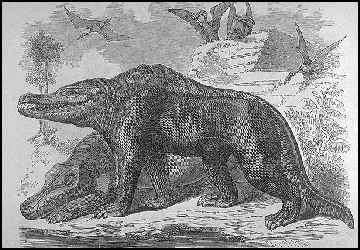
A
early drawing of a Megalosaurus.
|
Science and dinosaurs became acquainted around
1815 through a gentleman named William Buckland. Buckland
had acquired some large fossil bones from Stonefield quarries
near Oxford, England. Buckland recognized these bones as belonging
to what appeared to be a lizard of enormous size. He named his
find Megalosaurus which means "Great Lizard." According
to his calculations, the animal must have exceeded forty feet
in length and weighed as much as a large elephant.
Though Buckland was not the first person to find
a Megalosaurus bone (Robert Plot described one as far
back as 1676) he was the first to realize that these fossils
belonged to an unknown class of huge reptiles.
In 1842 Richard Owen, of England, wrote
an article reviewing the fossil evidence of these large reptiles.
By then three species were well known: Megaloasurus, Iguanodon,
and Hylaeosaurus. Owen noted that all three animals had
similar structures in their vertebrae and decided that they
should all belong to a new sub-order of the Saurian order. He
coined the term of this sub-order Dinosauria, or "terrible
lizards" and the name stuck.
These huge lizards fired the imagination of 19th
century scientists and the general public alike. People marveled
at the drawings made from their early study of dinosaur fossils.
Scientists fought over excavation sites so they could be the
first to discover and name new species.
One early fan of dinosaurs was Queen Victoria's
husband, Prince Albert. He often attended Owen's lectures and
in 1852 was instrumental in convincing Owen to assist in creating
an outdoor exhibit of prehistoric creatures based on Owen's
ideas about how the creatures looked.
The Monsters of Sydenham Park
|
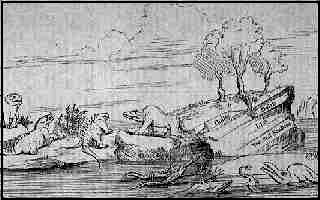
A
drawing of the Sydenham Park exhibit.
|
In 1854 Benjamin Hawkins, a sculptor, was
commissioned to make the full-size concrete replicas of the
dinosaurs and other extinct reptiles for Sydenham Park just
outside of London. The park was the new home of a huge glass
building known as the Crystal Palace which had housed the Great
Exhibition of 1851. The animals, designed by Owens and built
by Hawkins, were displayed in a natural setting. They included
Igauanodon, Hylaeosaurus, Megalosaurus, Plesiosaurus
and Ichthyosurus. The last two (being marine reptiles)
were shown swimming in a shallow lake.
The exhibit opened with much fanfare. On the first
night a dinner was held for twenty-one distinguished scientific
guests in the belly of one of the giant igauanodon statues.
Invitations to this gala event were sent out on artificial pterodactyl
wings. The scientists attending the dinner were so boisterous,
due to the large amount of alcohol they consumed, that their
singing could be heard across the entire park.
Owen's and Hawkins' interpretation of the creature's
appearances affected how dinosaurs and other large extinct reptiles
were drawn and viewed for a good twenty-five years. The truth
is that the men had very few bones to work with and their interpretations
were based as much on conjecture as physical evidence. Owens
instructed Hawkins to make the creatures look more like mammals
than reptiles because it fit his scientific theories. We now
know that dinosaurs looked quite different from the spectacular
models Hawkins produced. Still, the exhibit was a huge success.
Though the Crystal Palace burned to the ground in 1936, Hawkin's
models can still be seen today in Sydenham Park south of London.
|
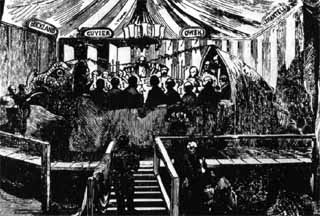
The
dinner held in the Sydenham Park Igauanodon.
|
So far dinosaurs had only been found in Europe.
In 1858, however, the first American dinosaur was found in the
small town of Haddonfield, New Jersey. The creature was named
Hadrosaurus foulkii, after the town and the discoverer,
William Parker Foulke, and aroused interest in dinosaurs in
the United States. The Hadrosaurus was an extremely important
find. It was the first nearly complete dinosaur skeleton ever
seen and taught scientists that at least some dinosaurs walked
upright on two feet. Up to this point most scientists had thought
that all dinosaurs walked on four feet like other reptiles.
The Museum That Never Was
One-hundred miles north of Haddonfield in New
York City, success of the Crystal Palace dinosaurs in London
reached the ears of Andrew Green, head of the Board of Commissioners
of Central Park. At that time, in 1868, the park was under construction.
Green decided a Paleozoic Museum, like the one at Sydenham,
would be a nice addition. He wrote to Hawkins saying, "It gives
me great pleasure to propose to you to undertake the resuscitation
of a group of animals of the former periods of the American
continent."
New York City at that time had no significant
natural history museum or society and was jealous of cities
like Philadelphia which had the Academy of Natural Sciences.
Green felt that the paleozoic museum would bring a "degree of
culture and advancement" to the city.
Hawkins came to the United States and established
a workshop in Central Park to build the molds necessary to cast
the prehistoric creatures. The museum was to be quite spectacular.
An iron framework held up by columns was to cover a small park.
In the park, replicas of two Hadrosaurs were to be shown
under attack by the carnivorous LaeLaps. In a shallow
lake the marine reptile Elasmosaurus would frolic. Extinct
mammals, including mastodons, giant sloths, giant elk, and giant
armadillos would also be featured. The price tag for the project
was $300,000.
Learn
More about the Great Paleozoic Museum that was never
built by watching our flash
film.
|
The project was well underway in 1870 when the notorious politician
William "Boss" Tweed came to power in New York City. Finding
no way he could profit via illegal kickbacks from the museum,
Tweed determined to destroy it. He packed the park commission
with his own people who then voted to put a stop to the project
and destroy the foundations that had been laid.
|
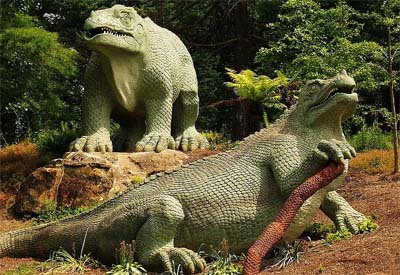
The
dinosaurs Hawkins built still inhabit Sydenham Park. (Creative
Commons)
|
Hawkins persisted, however, and Tweed decided
more drastic action was needed. A year later thugs, sent by
Tweed, broke into the workshop and smashed the dinosaurs with
sledge hammers. Later, they came back and did the same to Hawkins'
molds and small scale models. Hawkins was shocked and disgusted
with this episode and after a stint on the staff at Princeton
University, returned to England. And so the Great Paleozoic
Museum of Central Park became the museum that never was.
The Great Bone War
The Elasmosaurus that was to be featured
in the Great Paleozoic Museum was a recent discovery of a scientist
named Edward Drinker Cope. Cope was associated with the
Academy of Natural Sciences in Philadelphia and spent much of
his time in Haddonfield, New Jersey, where the first American
dinosaur had been dug up in 1858. Cope had an arrangement with
the quarries in the area to sell him any fossil bones they found.
|
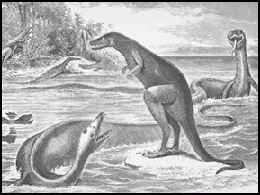
The
elasmosaurus with the head on the wrong end.
|
In the spring of 1868 Cope invited another distinguished
scientist, Othniel Charles Marsh from Yale University
and the Peabody Museum in Connecticut, to visit him. Cope showed
Marsh around the area quarries. To Cope's surprise, soon afterward
the stream of fossils he was getting from these quarries dried
up. Cope investigated and concluded that Marsh had paid off
the quarry owners to have new fossils sent to him. This incident
sparked a feud between the two men that would last almost thirty
years.
In 1870 the rivalry was raised to a new level.
Cope had just finished piecing together the skeleton of the
elasmosaurus. The elasmosaurus (whose name means "Plated
Reptile") was a long-necked, long-tailed marine reptile that
lived at the same time as the dinosaurs. Marsh examined Cope's
work and realized Cope had made the mistake of mounting the
head on the end of the tail. In an article he wrote Marsh jokingly
suggested that Cope should have named the creature Steptosaurus,
which means "twisted reptile." Cope was mortified and attempted
to buy up all the pictures of his mistaken reconstruction and
have them replaced with corrected versions. Cope didn't get
them all, though, and some drawings depicting the elasmosaurus
with its head on the short end, which is the wrong end, survive
.
The next year Cope returned the favor to Marsh
by stealing away one of his assistants and digging in one of
his excavations in Kansas. Neither Cope nor Marsh did much of
the actual shoveling, but employed collectors to do the excavations
for them. Since both Cope and Marsh were wealthy men and, as
one paleontologist once put it, neither was "overly scrupulous"
they could lure each others collectors away with promises of
more money.
This soon escalated into a full-scale competition
to see which scientist could discover the most new species and
amass the largest collection. Excavating a new find didn't mean
nearly as much as publishing a scientific report on the creature.
With this end in mind, Cope spent much of his fortune in buying
a controlling interest in the journal American Naturalist
so he could more easily speed his articles into publication.
Both Cope's and Marsh's articles became less and less informative
and more and more attacks on each other, thinly veiled as "scientific
criticism."
Out in the field, both men's collectors were busy
digging up fossils and spying on each other. In 1877 both teams
got wind of large bones at Como Bluff in Wyoming. This turned
out to be one of the most significant fossil beds ever found.
"...they tell me the bones extend for seven miles and are by
the ton..." wrote Samuel Williston, a collector, to Marsh.
The rival collectors started destroying minor
and incomplete fossils to prevent the other side from finding
them. Fights nearly broke out over digging sites.
Back on the east coast the feud, which had been
known only in scientific circles up till then, made the papers.
The front page of the January 12, 1890 edition of the New York
Herald led with the headline:
SCIENTISTS WAGE BITTER WARFARE
The article contained claims from Cope that Marsh
had stolen fossils, plagiarized articles and was generally incompetent.
The scientific community was embarrassed, but the Cope/Marsh
rivalry heightened the interested of the public in paleontology.
|

Othniel
Charles Marsh
|
|

Edward
Drinker Cope
|
The feud finally came to an end 1897 when Cope
(right) died after using up his entire fortune in the
dinosaur hunt. Marsh (left), who was better funded because
of his connection with the U.S. Geological Survey, was the final
winner having a larger collection than Cope and having discovered
more species.
However, there is a story that Cope offered a
final challenge to Marsh. After his death Cope bequeathed his
body to science. He directed that the volume of his skull was
to be measured. If Marsh did the same thing, then history would
know who was the smarter man.
Marsh didn't take up Cope's challenge, and today
we know such a measurement is not a very good indicator of intelligence.
Until very recently, however, Cope's skull sat on display in
a glass case at the Academy of Natural Sciences in Philadelphia,
looking out over the collection he helped to amass. It remains
a reminder of those early years of dinosaur discovery in the
19th century.
 Virtual
Cyclorama: The Paleozoic Museum That Never Was
Virtual
Cyclorama: The Paleozoic Museum That Never Was
|
Artists's
conception of the Paleozoic Museum of Central Park that
was never built (Copyright
Lee Krystek, 2002).

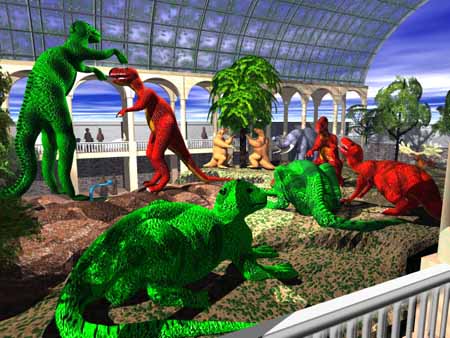
|

Copyright Lee Krystek
1999. All Rights Reserved.